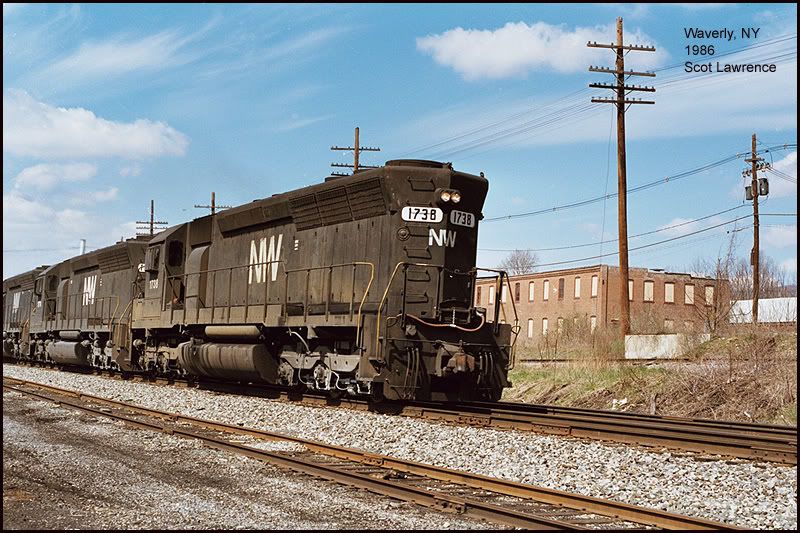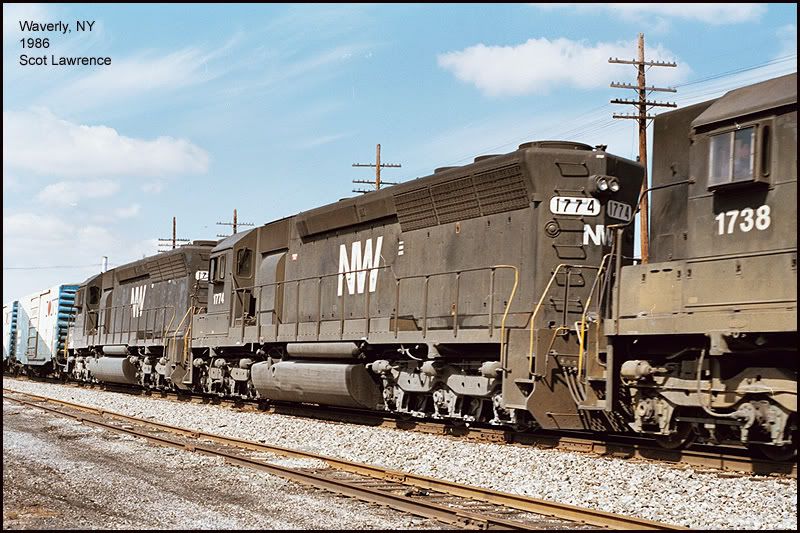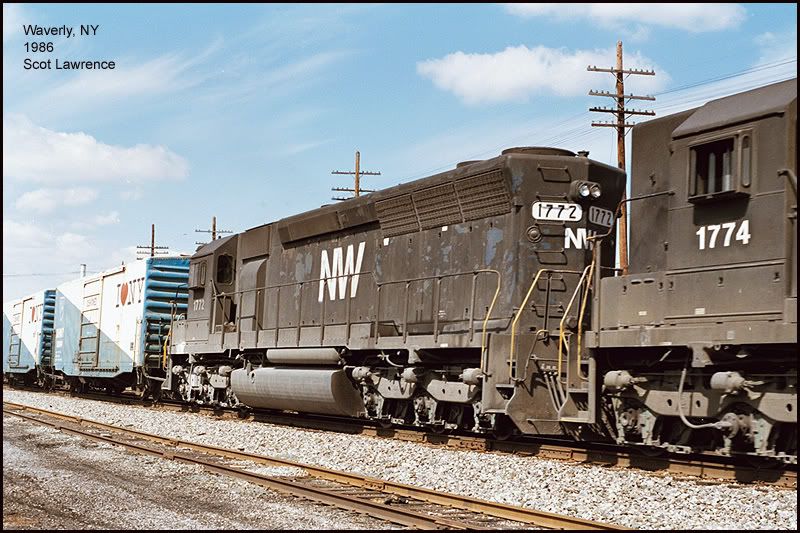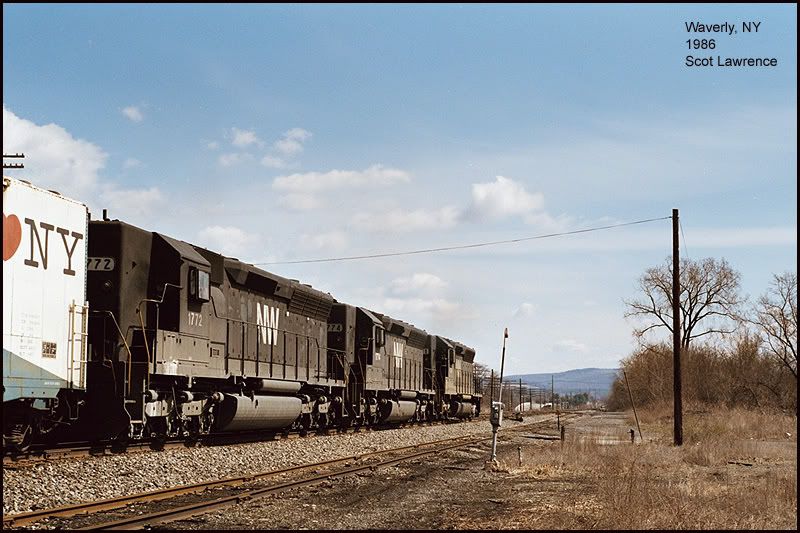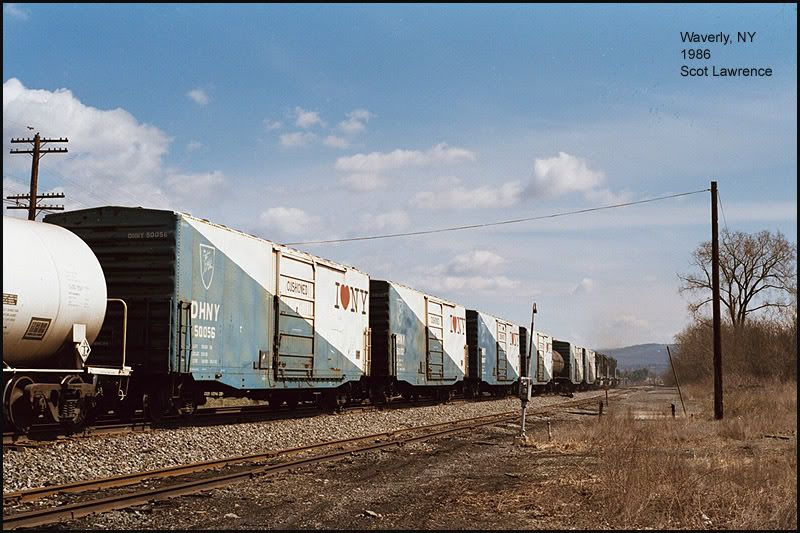Why do they reverse the second locomotive when they double or triple head locomotives in a unit train? Could they all run facing forward?

4,298 posts
·
Joined 2008
My guess and it is only a guess is that by doing that, when the train reaches its destination the engines can be moved to the other end of a new train without being turned around.
Chuck
Chuck
4 posts
·
Joined 2012
Railways have limited locations at which locomotives can be turned. ( Loops/Wyes/Turntables ) The easiest way is to have back to back consists allowing you to simply change ends when you reach the turnaround point. The direction they are facing does not effect performance. You can run the lead locomotive long hood forward, though visibility is severely restricted.
Shane
Shane
523 posts
·
Joined 2008
There's no mechanical need to run most diesel locomotives back to back..
i think this is merely a convenience factor that began in the late 1940s with the arrival of F-type locomotives which really only had visibility on one end. On the other hand, there are some railroads which are often running engines "elephant style" such as Amtrak.
i think this is merely a convenience factor that began in the late 1940s with the arrival of F-type locomotives which really only had visibility on one end. On the other hand, there are some railroads which are often running engines "elephant style" such as Amtrak.
807 posts
·
Joined 2008
All good points, but you've missed one important factor.
There is no reason to have the engines facing the same way. So, when making up a consist for a train, why bother? It's simply not an issue, except for (usually) the lead unit. I have seen too many consists with two engines pointing the same direction (when they KNOW it will have to be run the other way because of the route) to think the railroads bother trying to have engines turned right on each end. It's mostly random chance that puts the trailing units facing one direction or another.
There is no reason to have the engines facing the same way. So, when making up a consist for a train, why bother? It's simply not an issue, except for (usually) the lead unit. I have seen too many consists with two engines pointing the same direction (when they KNOW it will have to be run the other way because of the route) to think the railroads bother trying to have engines turned right on each end. It's mostly random chance that puts the trailing units facing one direction or another.
2,892 posts
·
Joined 2008
Posted By DKRickman on 30 Apr 2012 07:23 AM
It's mostly random chance that puts the trailing units facing one direction or another.
This must depend on the particular railroad.
I have been watching for this specifically, two locos not back-to-back, and on both CN and CP I have only seen that once in the last 20 years.
It's mostly random chance that puts the trailing units facing one direction or another.
This must depend on the particular railroad.
I have been watching for this specifically, two locos not back-to-back, and on both CN and CP I have only seen that once in the last 20 years.
239 posts
·
Joined 2011
I know for certain that the St Maries River Railroad, a very small shortline, runs them opposite for the express purpose of return trips, when they get to the end they swap locos and head home. They have no way to turn them around easy on there out and back runs. In plummer with effort they could but when they ran to Clarkia there was no place to turn around. I think this is simply a matter of convienience for them and I would assume for many others. Maybe not UP or BNSF or the likes but for the smaller roads. When it comes to big consists where there is three or more it does seem random. I especially like when there is two back to back in the front and two back to back to back in the rear. If the train is parked it is somewhat difficult to decide which way its going other than the light.
3,561 posts
·
Joined 2010
Here in the South West I see a big variety of loco combos!
UP does run in a very random order ...But what is most noticed are sets of 2 locos, 1 SD70M & 1 dash-9 running in pairs, more often than any other combo.
N.S. runs elephant style thru here, 2-3 locos mixed with UP, cab forward.
BNSF runs cab forward with UP.
CP & CN run cab forward, mixed with UP.
CSX mostly runs elephant - cab forward also, mixed with UP.
Out watering garden and 3 units went by; a dash-9, SD70ACe, SD70M, all elephant - so go figure!! All UP "lellow...!
Dirk
DMS Ry.
UP does run in a very random order ...But what is most noticed are sets of 2 locos, 1 SD70M & 1 dash-9 running in pairs, more often than any other combo.
N.S. runs elephant style thru here, 2-3 locos mixed with UP, cab forward.
BNSF runs cab forward with UP.
CP & CN run cab forward, mixed with UP.
CSX mostly runs elephant - cab forward also, mixed with UP.
Out watering garden and 3 units went by; a dash-9, SD70ACe, SD70M, all elephant - so go figure!! All UP "lellow...!
Dirk
DMS Ry.
5,870 posts
·
Joined 2007
One thing I learned here on MLS is that some engines have a F stenciled near the steps and that is the " Front" of the engine.
JJ
JJ
17 posts
·
Joined 2009
Unless the cab has dual control stands, long hood foreward is considered backing up. Another rule of thumb is the engineer rides on the right, the conductor rides on the left(fireman side).
~CLBee, North Carolina Transportation Museum Rail Ops Volunteer
~CLBee, North Carolina Transportation Museum Rail Ops Volunteer
24,636 posts
·
Joined 2008
Umm... I think you will find several roads that ran long hood forwards. (I guess they have to repaint the F on the other end of the models we get)
http://en.wikipedia.org/wiki/Long_hood
Greg
http://en.wikipedia.org/wiki/Long_hood
Greg
17 posts
·
Joined 2009
Yes, Southern ran long hood forward as did N&W. N&W 620(GP9) has dual control stands, and we sometimes operate it long hood forward. Southern ran RS-3s long hood forward with the "F" on the long hood. To my memory, my Aristo RS-3 has the Front designation on the long hood end.
5,870 posts
·
Joined 2007
I always run my NW-2s with the hood in the back which is Backwards. Just about every time I saw one that was the way it was being run. It gives the engineer a wider view.
JJ
JJ
68 posts
·
Joined 2012
Look at the Classic Trains photo of the day: http://ctr.trains.com/home/online%20extras/photo%20of%20the%20day.aspx?utm_source=SilverpopMailing&utm_medium=email&utm_campaign=CTR_News_120404_final&utm_content=
350 posts
·
Joined 2008
Hey JJ,
The N&W for the most part ran the short hood foward, that picture is a rarity. The Southern ran theres th long hood foward. That is why on a N&W had the bell on the short hood, an Southern had the bell on the long hood nose. Rex
The N&W for the most part ran the short hood foward, that picture is a rarity. The Southern ran theres th long hood foward. That is why on a N&W had the bell on the short hood, an Southern had the bell on the long hood nose. Rex
4 posts
·
Joined 2012
"There is no reason to have the engines facing the same way. So, when making up a consist for a train, why bother? It's simply not an issue, except for (usually) the lead unit. I have seen too many consists with two engines pointing the same direction (when they KNOW it will have to be run the other way because of the route) to think the railroads bother trying to have engines turned right on each end. It's mostly random chance that puts the trailing units facing one direction or another."
I'm afraid this is untrue, at least at CN. Walker yard in Edmonton has a turn table which is used to properly set up most consists. One exception lately involves the new GE engines with trip optimiser. More and more of these consists are being set up front/front, requiring them to be wyed at the other end, thus keeping the optimized unit in the lead. Locomotives can not run backwards in Canada unless equipped with ditch lights and a pilot on the trailing end. There is also language in the engineers collective agreement requiring that single units be operated cab forward from terminals, and if turned on line "all efforts will be made to turn the locomotive enroute."
Shane
I'm afraid this is untrue, at least at CN. Walker yard in Edmonton has a turn table which is used to properly set up most consists. One exception lately involves the new GE engines with trip optimiser. More and more of these consists are being set up front/front, requiring them to be wyed at the other end, thus keeping the optimized unit in the lead. Locomotives can not run backwards in Canada unless equipped with ditch lights and a pilot on the trailing end. There is also language in the engineers collective agreement requiring that single units be operated cab forward from terminals, and if turned on line "all efforts will be made to turn the locomotive enroute."
Shane
3,037 posts
·
Joined 2008
Posted By Santafe 2343 on 02 May 2012 04:18 PM
Hey JJ,
The N&W for the most part ran the short hood foward, that picture is a rarity. The Southern ran theres th long hood foward. That is why on a N&W had the bell on the short hood, an Southern had the bell on the long hood nose. Rex
I wouldn't say "for the most part" N&W ran short hood forward..thats not really true.
in the early diesel era both Southern and N&W were primarily long hood forward, and high short hoods..
By the 2nd generation diesel era (1960's and 70's) N&W was going more "traditional" (short hood forward and chopped short hoods)
while Southern held on to the old ways longer than did N&W..
but I would guess "for the most part", taking in the entire diesel era for the N&W (up to 1982)
N&W had more long-hood forward, and high hoods, than the other way around..
Scot
Hey JJ,
The N&W for the most part ran the short hood foward, that picture is a rarity. The Southern ran theres th long hood foward. That is why on a N&W had the bell on the short hood, an Southern had the bell on the long hood nose. Rex
I wouldn't say "for the most part" N&W ran short hood forward..thats not really true.
in the early diesel era both Southern and N&W were primarily long hood forward, and high short hoods..
By the 2nd generation diesel era (1960's and 70's) N&W was going more "traditional" (short hood forward and chopped short hoods)
while Southern held on to the old ways longer than did N&W..
but I would guess "for the most part", taking in the entire diesel era for the N&W (up to 1982)
N&W had more long-hood forward, and high hoods, than the other way around..
Scot
-
?
-
?
-
?
-
?
-
?
-
?
-
?
-
?
-
?
-
?
-
?
-
?
-
?
-
?
-
?
-
?
-
?
-
?
-
?
-
?
- posts
- 461K
- members
- 32K
- Since
- 2007
A forum community dedicated to G scale model train owners and enthusiasts. Come join the discussion about collections, displays, models, styles, scales, reviews, accessories, classifieds, and more!
Explore Our Forums
Top Contributors this Month
View All
Greg Elmassian
60 Replies
Pete Thornton
31 Replies
ferroequinologist
22 Replies

